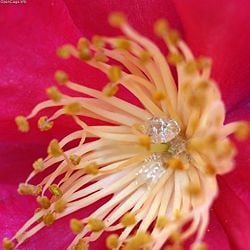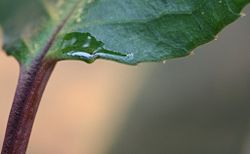Nectar
- For other uses of "Nectar", see Nectar (disambiguation).
Nectar is a sugar-rich liquid produced by plants. It is produced either by the flowers, in which it attracts pollinating animals or by extrafloral nectaries, which provide a nutrient source to animal mutualists providing anti-herbivore protection. It is produced in glands called nectaries.
Etymology
Nectar is derived from Latin nectar "drink of the gods", which in turn has its origins in the Greek word νέκταρ (néktar), presumed to be a compound of the elements nek- "death" and -tar "overcoming". The earliest recorded use of its current meaning, "sweet liquid in flowers", dates back to 1609.[1]
Floral nectaries
Floral nectaries are generally located at the base of the perianth, so that pollinators are made to brush the flower's reproductive structures, the anthers and pistil, while accessing the nectar.
Extrafloral nectaries
Nectar produced outside the flower is generally made to attract predatory insects. These predatory insects will eat both the nectar and any plant-eating insects around, thus functioning as 'bodyguards'.[2] Extrafloral nectaries are generally located on the leaf petioles, mid-rib or leaf margin. They are thought to be modified trichomes and exude nectar which is sourced from phloem sap. Extrafloral nectaries can be found on species belonging to (amongst others) the genera: Salix, Prunus and Gossypium.
Nectar is economically important as it is the sugar source for honey. It is also useful in agriculture and horticulture because the adult stages of many predatory insects, as well as hummingbirds and butterflies, feed on nectar.
- ↑ Douglas Harper. Online Etymology Dictionary. Retrieved on 2007-09-26.
- ↑ Plant-Provided Food for Carnivorous Insects - Cambridge University Press

